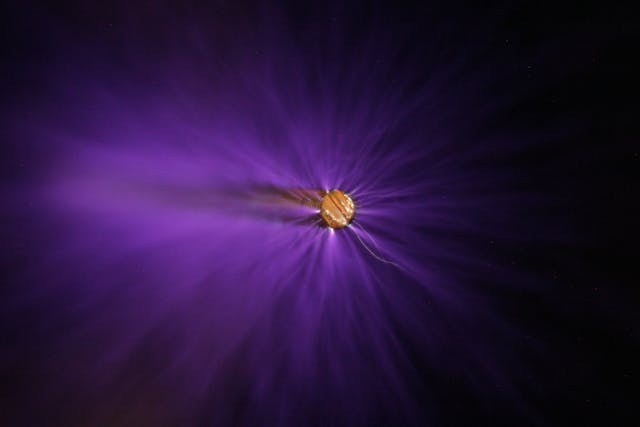Media | Articles
Could 1980s technology keep internal-combustion engines on the road?
Read enough automotive-related articles on the internet and you will be convinced the internal-combustion engine is being hunted with a fervor typically reserved for villains in Liam Neeson movies. Okay, that conclusion may be extreme—but it holds some truth. Regulations regarding emissions and engine efficiency grow stricter with each passing year and manufacturers are faced with an impossible task: Take a centuries-old design and make it endlessly better—faster, cleaner, stronger, ad infinitum. At some point, progress will plateau, and the cost of ICE experimentation will simply outweigh the incremental gains in efficiency and power. The good news? The internal-combustion engine might have one more trick up its cylinder sleeve.
Fuel, air, and spark—the three things an engine needs to run. Air is one ingredient that it makes sense to leave alone. Fuel type is essentially decided by contemporary infrastructure. (Synthetic fuels are in the works, but we’re thinking of large-scale changes in the ICE design that would extend far beyond the top echelons of motorsport to the everyman (and woman) on the street.) That leaves spark as the low-hanging fruit in this equation. If a different type of ignition could more completely burn the fuel and air mixture, it would not only reduce emissions but also increase efficiency.
Enter plasma ignition.

Traditional spark ignition is very simple. A coil transforms the 12 volts from the car’s charging system into thousands of volts that discharge quickly to jump between the electrode and the ground strap of a spark plug. This forms a sharp but small zap that lights off the chemical chain-reaction that expands the air and fuel mixture to push the piston down and thus rotate the crankshaft. In order for the fuel-and-air mixture to be lit by this type of ignition system, it needs to be fairly close to a stoichiometric mixture; right around 14.7 to 1. That ratio—14.7 grams of air to one gram of fuel—puts a ceiling on efficiency. But here’s where things get interesting.
If we were able to lean out the mixture by adding air but still getting the same in-chamber expansion, and the corresponding force exerted on the piston, efficiency would increase dramatically. A lean mixture is much harder to ignite, though. So hard that you’d need transient plasma to make it happen in any reliable fashion. Technically, the spark on a standard spark plug does create plasma when it ionizes the gasses between the electrode and ground strap; transient plasma takes that small arc and dials it up to 11. If a spark plug is a zap in the chamber, plasma ignition is a TIG welder mounted in a cylinder head.
Marketplace
Buy and sell classics with confidence

This much more violent mode of ignition can regularly and predictably ignite extremely lean air/fuel mixtures. One of transient plasma’s most obvious advantages, besides a higher-efficiency combustion cycle, is that relatively low amounts of energy are used to perform a lot of electronic “work.” (The difference between energy and power, for those of you who enjoy recalling high school chemistry class.) The spark itself is not lighting a fire to burn the fuel; rather, a rapid-fire sequence of low-range electronic pulses generates a highly potent electric arc, which then breaks the bonds holding the oxygen molecules together and allows the electrons to shoot out, essentially attacking the hydrocarbons (fuel) and creating combustion. This means we are not waiting on a flame to consume the fuel and, in the amount of time between combustion and exhaust strokes, we get a more complete burn.
The most fascinating part? This technology is not new. We traced the basic concept to patents from the 1980s, but technology has obviously come a long way since then. Outfits like Transient Plasma Systems, Inc. and Ionfire Ignition are reviving the concept and the reintroduction is timed quite nicely. (If you’ll forgive the pun.) TPS ignition systems have been tested and show a 20 percent increase in efficiency while also decreasing harmful emissions like NOx by 50 percent. Numbers like that aren’t a silver bullet in the ICE gun, but plasma ignition could keep our beloved internal combustion engines on the road longer than we’d expected. TPS claims it is working with manufacturers to integrate its ignition tech into production engines, but we are still a few years away from seeing the fruit of that collaboration.
The internal-combustion engine has undergone constant evolution for centuries, and at this point we’re extracting incremental gains. Plasma ignition could be one of the last significant improvements to be found in the ICE story. Here’s hoping that this ’80s tech, refined for the 21st century’s needs, makes its way onto the streets.












Extremely interesting article! This is the 1st time I’ve heard of the concept of plasma ignition. Hopefully the auto manufacturers will see the value of further developing & then incorporating it into future ICE models rather than simply going all in on EVs. I’ve grudgingly become more open to an EV future, but still recognize the short-term and long-term problems with relying on EVs. Perfecting plasma ignition ICEs would address a lot of shortcomings EVs have when it comes to national security and infrastructure limitations. I wonder if plasma ignition technology might someday be able to be incorporated into classic & antique ICE vehicles. Probably not is my guess.
I think the real issue is going to be the cost and availability of gasoline. The demand will decrease significantly and gas will be like liquid gold.
Joel – in the roughly 100 years of recorded gasoline/oil production numbers from national producers and consumers alike, there is one constant – the higher the demand, the higher the price. The lower the demand, the lower the price. As EVs phase in and ICE fades out, the saudis and their like are painfully aware they will have no more value in their oil, hence their rapid “expansion” via the saudi wealth fund into non-fuel businesses and similar diversified revenue producers.
Isn’t this what electronic ignition already does? How does this differ from the already existing electronic ignition systems? If the mixture is too lean and combustion too hot, could it burn a hole in the top of the piston?
My thoughts:
The heat generated by such a hot spark may be too intense for conventional metals.
Another thought with cooling and raising compression is the WW2 water injection on aircraft.
I am curious, and would love for others to affirm or destroy the practicality of these concepts.
Sam, I had the same thought on water ignition to increase compression.
Interesting article, but there is really nothing terrible about ICE and electric vehicles being able to coexist. People who are purchasing vehicles should be able to choose what is best for their particular situation.
Well, the problem with ICE is primarily with the emissions. If this technology could substantially reduce emissions, that would be a big win. It would be exactly what you are hoping for–a way for ICE engines to remain on the road longer.
Emissions are only a problem if you are a bureaucratic suit working for the EPA in Washington.
Apparently, you’re too young to recall the LA smog of the 1950s.
That smog is still there, just not as “leaded” now lol
I mean no disrespect, Bob, but would like to share an eyeopener that I experienced a few years ago.
We may look up and think our atmosphere is vast … but … imagine a basketball wrapped in a single thin film of saran wrap. The saran wrap represents our atmosphere relative in size to the basketball Earth … and you know what else … you’re STILL thinking too thick! Our atmosphere is so thin and fragile that we need to take better care of it. That ,of course, is why we have an EPA. They may not be perfect but at least someone has a job to pay attention to this place where we all live.
True. Emissions are 90+% less than the bad old days.
I agree with you 💯, this big push for EV’s is total BS. The tree huggers pushing the EV’s do not want to speak about how environmentally dirty they actually are, mining of the lithium is very dirty and hazardous to the environment along with the fact that disposal of old batteries is totally environmentally filthy. It’s like nuclear energy is, if nuclear wasn’t so dirty and wast could be disposed of safely everything in the world would be running on it today. When it was first used they didn’t want to tell us how dangerous and dirty it was just as they are doing now with this battery crap!
Bob-are you trying to be funny? Do you Really think all the pollution dumped into our land/Air & water does NO Damage?
Emissions are a real problem that affects the lives of millions of people with cardiac and pulmonary diseases. Cleaner air benefits everyone, not just the ones with these serious and life-threatening conditions. The rights of everyone to breath cleaner air are more important than the rights of people who want to make it worse.
THEY want us all to believe emissions is the main problem with ICE vehicles, but are they?
Yup, ‘cuz everything revolves around you…
I’ve heard about this for a few years. I do wonder why nothing has come of this.
We fooled around with plasma ignition in the mid-‘Eighties on a nitro engine in our funny car. I say “fooled around” because we didn’t know enough about it to make it work consistently. We had a NASA engineer design and build our prototype system but while the engine would start and idle, it wasn’t happy under load above 4000 rpm with 42 percent blower overdrive, 45 degrees of lead and 85 percent nitromethane. Cylinder pressure and fuel volume was too much for the little kernel to cope with and the fire would go out. Nice to see that the principle is still in use, though.
And how long would the spark plugs last? Would the electrodes be consumed? Also, I will presume this system could not use traditional distributor points.
This would be a very good thing given the recent revelations of the E-Car’s vulnerabilities in hurricane events and infrastructure deficiencies, most notably in CA. We can not ignore these issues and pretend the impact of the battery replacements and their catastrophic failure/HAZMAT issues when salt water is added to these revolutionary vehicles doesn’t exist and say we are moving in a “Green” direction with them. E-Cars are just another agenda at this point. We have one non-operational charging station in a 100 mile radius of our Area here in Northern New Mexico. Our Electric CoOp is not able to support a full transition to this scheme…
EVs are a niche. The niche may grow in size but will remain a niche. Because of the amount of materials needed for current batteries this niche is not scalable to replace IC engines.
Correct, and to say we are equipped to charge ever more EV vehicles is absurd too. Hasn’t CA had ‘no charge’ days already.
As mentioned earlier, the lithium mining, battery manufacturing, and waste disposal associated with EVs are enough to keep any reasonable thinking person away.
I have worked in R&D for the automotive industry for 25 years across a combination of OEM’s, government labs, and private labs. While plasma ignition has some nice features, it isn’t likely to give us all that much more efficiency in the real world. Yes, it can let a spark ignited engine run quite lean, but then we can’t meet emissions regulations – lean burn emission control is an order of magnitude more complicated than a three way catalyst and costs maybe 2-3 times as much to put on the car. So we have to stick with a stoichiometric mixture to be able to meet emissions. A plamsa ignition system just doesn’t offer much benefit then. A decade ago this may have had a chance. But the efficiency benefit from a hybrid system is way more than you’ll get from the engine and would cost about the same as trying to do lean burn, plasma ignition, and lean catalysts.
IMO, hybrids are the sweet spot of technology.
Plasma ignition does need to be explored. But part of the problem is over sized and overpowered daily drivers. I have always preferred driving smaller vehicles because they are easier to drive & park and are more efficient. When the price of fuel went down most people quit buying reasonable vehicles and piled into big trucks & SUVs. Now that fuel is expensive again they cry at the gas pump. I saw it coming so why didn’t they?
Well summed, Rick. But such logic requires people to examine their own actions, when it’s easier for them to blame “thuh government,” “thuh politicians.” Most full-size pick ups we see are empty, always empty, fashion statements for suburban cowboys, for some reason unable to rent a truck or have delivered those two 4 x 8 sheets of plywood a year. Lotta unrequited testosterone out there.
Then we’ve got four-door “crossovers” wearing badges once synonymous with sports cars. And for the past three decades, we’ve had the oxymoron of “sport utility vehicle.” Most Americans, by dint of living on a vast continent still viewed as inexhaustible cornucopia, suffer a “having it all” mindset.
Look at the names of the various pick ups, SUVs. They scream macho, wild west.
The biggest problem as I see it is that people like Elon Musk, GM, Ford etc. and now even Rolls Royce, have jumped on the band wagon, and there is no way that they are going to forego the many billions of dollars that have been invested in EV technology until they have got most of their investment back. If Plasma Ignition is introduced alongside electric powered vehicles then it might stand a chance of surviving, if not I think it is doomed.
Very interesting Article. Just wondering why MSD is not standard across all ice engines.
When I saw that lead-in photo referencing the title of the article, I thought to myself, “could the Buick Grand National be the Rosetta Stone of technology that saves the combustion engine?”. I guess I’m a sucker for taking that bait.
Lean mixtures burn hot, very hot. 14.7 to 1 is already very hot. How much do you want to spend on a motor built to take these temperatures?
Remember, all that “wasted fuel” is carrying tremendous amounts of heat out of your engine.
If you would like a clue as to what such an engine would cost, take a look at the price of a gas turbine engine. They are built to run on the lean side of peak EGT (exhaust gas temperature).
I was waiting for someone to mention the heat caused by lean burn! Nothing like little holes in your pistons to ruin your day.
By the way, as I see it all the manufacturers are jumping into the EV mix due to CAFE, so they can keep on making all the ICE vehicles most all of us want and need. These folks may not be all rocket scientists but they do know business and probably would not spent the money developing a technology that the government has to pay us to use and coerce them to spend on.